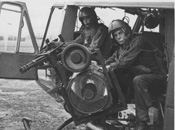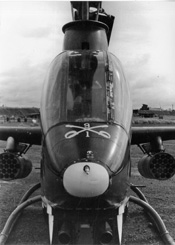Vietnam: The Helicopter War
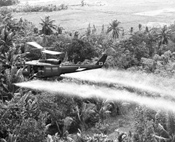
Spraying Agent Orange. Mekong Delta near Can Tho Defoliation Mission 336th Avn. Co. Stationed at Can Tho
Bryan Grigsby Collection Department of the Army Special Photographic Office (DASPO) [VA002930]
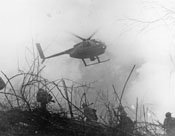
OH-6 light observation helicopter
U.S. Army Aviation Museum Volunteer Archivists Collection [VA059102]
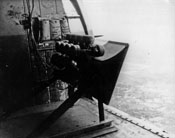
Loudspeaker in UH-1, used to talk to Viet Cong as leaflets are dropped from a C-47 in Vietnam. Photographer: Varner Gain.
U.S. Army Aviation Museum Volunteer Archivists Collection [VA058522]
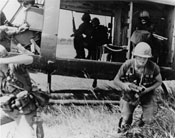
UH-1D, Co A, 2nd Battalion, 14th Infantry. Vietnam
U.S. Army Aviation Museum Volunteer Archivists Collection [VA058677]
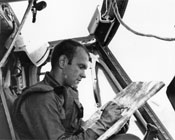
Pilot WO Wayne G. Hicks looks over a map prior to flying the People Sniffer mission at LZ Two Bits, 1st Squadron, 9th Cavalry - Photographer: James B. Egan
U.S. Army Aviation Museum Volunteer Archivists Collection [VA058757]
"The Only Easy Day was Yesterday:" Special Missions
With the plethora of armaments that could be added to helicopters, the amount of damage they could endure, and the seemingly endless amount of terrain they could take off from and land in, it is no surprise that they were also utilized in special missions during the war. Helicopters played a vital role in surveillance, psychological warfare, chemical dispersion, assault, and insertion operations. The helicopter's incredible versatility made these varied types of missions possible.
Firefly
Firefly missions, also known as Lightning Bug missions, used helicopters outfitted with searchlights to illuminate enemy vehicles and boats. Once the target was identified, armed helicopters would move in to destroy them, or gunners would fire tracer ammunition to mark the target for gunships. These missions were successful in the interdiction of enemy supplies.
Defoliation
Defoliation divider were used to strip away foliage which might conceal enemy activity. Airplanes, helicopters, and boats were employed during the early morning hours to spray in order to avoid high temperatures and winds, which could render a mission largely ineffective and could cause damage to friendly areas near the target. H-34 Choctaw and later UH-1 Hueys, helicopters were equipped with a 200-gallon capacity spray system. Defoliants were sprayed at a low speed of 50 knots and reached a clearing area extent of 75 meters.
Hunter-Killer
The OH-6 Cayuse helicopter, nicknamed "Loach" after the acronym LOH (Light Observation Helicopter) was commonly used during hunter-killer missions. Loaches, the "hunters," were equipped with side-looking radar or infrared heat detecting devices and flew low to the ground at a low air speed. These detection devices were used to locate enemy truck targets and to gain intelligence on enemy concentrations and movements.
Locations of enemy targets were passed from Loaches to AH-1 Cobra attack helicopters, also known as Huey Cobras. Huey Cobras served as the "killers" during hunter-killer missions as they were heavily armed with combinations of the following: one to two machine guns, one to two 40 millimeter grenade launchers, a 7.62-millimeter minigun in the nose turret and up to 76 2.75 inch rockets located beneath the stub wings.
Psyops
Rally leaflets constituted a large part of the psychological warfare operations that occurred during the war. Helicopters were loaded with packs of 20 million or more leaflets which encouraged the enemy to realize the futility of the war effort and appreciate American and Allied victories, intentions, and objectives. These leaflets would then be dropped, sometimes in accordance with bombing raids.
Rally messages were also broadcast from loudspeakers mounted in helicopters, vehicles, boats, and also hand carried megaphones. These broadcasts often accompanied leaflet drops and were similar in content to that of the printed messages.
Special Unit Insertion
Helicopters were also useful in the swift delivery and retrieval of special units teams, such as the Long Range Reconnaissance Patrol (LRRPs), the Military Assistance Command, Vietnam (MACV), the Studies and Observations Group (SOG), the Navy's Sea, Air, and Land Teams (SEALs), and the Army's Special Forces and the 101st Airborne Division.
People Sniffer
UH-1B, "Huey," variants were utilized during "People Sniffer" missions, which this pilot is preparing for. These helicopters were equipped with Airborne Personnel Detectors (APD), specifically the XM3, mounted in the interior, and scoops mounted below the wings. Detection of enemy activity or concentrations was accomplished through the release of chemical effluents into the air generated by humans, such as sweat or urine. Once targets had been located by the detector, teams would proceed with an assault.
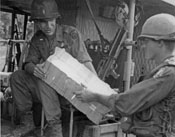
Military personnel, Psy War Activities. Sergeant Jaudon hands Psy War leaflets to be air dropped to 1st Lieutenant Paris sitting in UH-1. Photographer: Lyle Boggess
U.S. Army Aviation Museum Volunteer Archivists Collection [VA058760]
Bibliography
- Brennan, Matthew, ed. Hunter-Killer Squadron: Aero-Weapons, Aero-Scouts, Aero-Rifles, Vietnam 1965-1972. New York: Pocket Books, 1992.
- Dorr, Robert F. and Chris Bishop, ed. Vietnam Air Warfare: the Story of the Aircraft, the Battles, and the Pilots who Fought. Edison: Chartwell Books, 1996.
- 987VI0672, Michael Sheets Collection, The Vietnam Center and Sam Johnson Vietnam Archive, Texas Tech University.
- 20990117001, Richard L. Clarkson Collection, The Vietnam Center and Sam Johnson Vietnam Archive, Texas Tech University.
- 2171312015, Douglas Pike Collection: Unit 03 - Insurgency Warfare, The Vietnam Center and Sam Johnson Vietnam Archive, Texas Tech University.
- 2250207023, Douglas Pike Collection: Unit 03 - Technology, The Vietnam Center and Sam Johnson Vietnam Archive, Texas Tech University.
- 2520314007, Paul Cecil Collection, The Vietnam Center and Sam Johnson Vietnam Archive, Texas Tech University.
- VA002930, Bryan Grigsby Collection, The Vietnam Center and Sam Johnson Vietnam Archive, Texas Tech University.
- VA058479, U.S. Army Aviation Museum Volunteer Archivists Collection, The Vietnam Center and Sam Johnson Vietnam Archive, Texas Tech University.
- VA058522, U.S. Army Aviation Museum Volunteer Archivists Collection, The Vietnam Center and Sam Johnson Vietnam Archive, Texas Tech University.
- VA058677, U.S. Army Aviation Museum Volunteer Archivists Collection, The Vietnam Center and Sam Johnson Vietnam Archive, Texas Tech University.
- VA058757, U.S. Army Aviation Museum Volunteer Archivists Collection, The Vietnam Center and Sam Johnson Vietnam Archive, Texas Tech University.
- VA058760, U.S. Army Aviation Museum Volunteer Archivists Collection, The Vietnam Center and Sam Johnson Vietnam Archive, Texas Tech University.
- VA059102, U.S. Army Aviation Museum Volunteer Archivists Collection, The Vietnam Center and Sam Johnson Vietnam Archive, Texas Tech University.
- VA062411, Robin B. Bartlett Collection, The Vietnam Center and Sam Johnson Vietnam Archive, Texas Tech University.
Vietnam Center & Sam Johnson Vietnam Archive
-
Address
Texas Tech University, Box 41041, Lubbock, TX 79409 -
Phone
(806)742-9010 -
Email
vnca@ttu.edu


